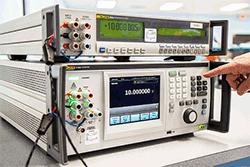Calibration Uncertainty
Uncertain About Your
Calibration Uncertainty?
One of the most commonly debated issues among accredited calibration professionals and often least understood by sensor users is the concept of measurement uncertainties.

To the novice user, the manufacturer’s stated calibration is simply accepted as gospel. However, a closer inspection of the calibration certificate reveals that the calibration lab is actually providing an INTERVAL, within which the value for the device is “certain” to lie and typically includes a statistical probability distribution statement. This omnipresent and expected interval is typically expressed in a tolerance term of plus or minus some level of percent… aka uncertainty.
In fact, some users have even been heard proclaiming that the need to know uncertainty must be “new”, since they have been ISO9001 certified for years and have never been asked before! However, these users were either lucky in passing or were meeting the requirement without knowing it. Clause 4-11-1 states that, “… equipment shall be used in a manner which ensures that the measurement uncertainty is known and is consistent with the required measurement capability.” To that end, we’ll embark on the foundation of understanding the measurement uncertainties associated with accelerometer calibration via comparison to a reference standard.
In this type of accelerometer calibration (governed by ISO16063-21), there is a fairly large list of contributors. This list of contributors is broken into two major classifications:
1. Random Contributors which results in deviations from calibration to calibration and
2. Systemic or Bias Contributors which cause a consistent deviation in the results for all calibrations.
The following table illustrates some of these various uncertainty contributors for the amplitude of a complex frequency response measurement. While not listed here, there are also corresponding uncertainty contribution calculation tables for phase.
|
Contributor |
Behavior |
|
Reference Sensor/Signal Conditioner Uncertainty |
Systemic |
|
Conditioning Amplifier Gain |
Systemic and Random |
|
Voltage Ratio Measurement |
Systemic and Random |
|
Transverse, Rocking, Bending Vibrations |
Random |
|
Temperature Effects |
Random |
Table 1 – Typical uncertainty contributors and their typical behavior
For a given measurement (or calibration) the calculated uncertainty may be anywhere from a fraction of a percent (excellent) to a few percent (typical) to high single digit or double-digit percentage uncertainties (poor). The best measurement uncertainties for accelerometer calibration are found in primary calibration systems utilizing laser measurement and the worst uncertainties are often found in “homemade” calibration systems which ignore a few key points in the measurement process and uncertainty chain.
Article Source: http://EzineArticles.com/expert/Michael_J_Lally/1304274
